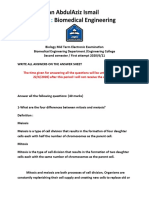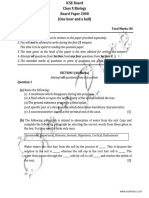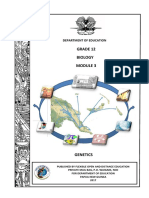Meiosis: Sexual Reproduction
Meiosis: Sexual Reproduction
Uploaded by
VivaMapwaCopyright:
Available Formats
Meiosis: Sexual Reproduction
Meiosis: Sexual Reproduction
Uploaded by
VivaMapwaOriginal Description:
Original Title
Copyright
Available Formats
Share this document
Did you find this document useful?
Is this content inappropriate?
Copyright:
Available Formats
Meiosis: Sexual Reproduction
Meiosis: Sexual Reproduction
Uploaded by
VivaMapwaCopyright:
Available Formats
REVIEWER BIO 01
MEIOSIS
Sexual Reproduction
Chromosomes are duplicated in germ cells
Germ cells undergo meiosis and cytoplasmic division
Cellular descendants of germ cells become gametes
Gametes meet at fertilization
Involves
Meiosis
Gamete Production
Fertilization
Produces genetic variation among offspring
Asexual Reproduction
Single parent produces offspring
All offspring are genetically identical to one another and to parent
Homologous Chromosomes Carry Different Alleles
Cell has two of each chromosome
One chromosome in each pair from mother and father.
Paternal and maternal chromosomes carry different alleles
Sexual Reproduction Shuffles Alleles
Through sexual reproduction, offspring inherit new combinations of alleles, which lead to
variation in traits.
Credits to Sir. Christian Martin Tan
Paul Francia
REVIEWER BIO 01
This variation in traits is the basis for evolutionary change.
Gamete Formation
Gametes are sex cells (sperm, eggs)
Arise from germ cells
Ex. Testes and Ovaries | anther and ovary in plants
Chromosome Number
Sum total of chromosomes in a cell
Germ cells are diploid (2n)
Gametes are haploid (n)
Meiosis halves chromosome number
Meiosis: Two Divisions
Two consecutive nuclear divisions
Meiosis I
Meiosis II
DNA is not duplicated between divisions
Four haploid nuclei form
Overview of Meiosis
Two nuclear divisions occur to make 4 haploid cells
Used to make gametes (egg and sperm)
Occurs in sex cells
Credits to Sir. Christian Martin Tan
Paul Francia
REVIEWER BIO 01
Has 8 phases (4 in each meiosis I & II)
Meiosis I
Meiosis II
The two sister chromatids of each duplicated chromosome are separated from each other.
Meiosis I – Stages
Credits to Sir. Christian Martin Tan
Paul Francia
REVIEWER BIO 01
Meiosis I
Prophase I
Homologous chromosomes pair (synapsis) and crossing-over occurs in which there is exchange
of genetic information.
Metaphase I
Homologous pairs lined at the equator
Anaphase I
Homologous chromosomes separate and move towards opposite poles.
Telophase I
2 daughter cells result each with 23 duplicated chromosomes.
Prophase I
Each duplicated chromosome pairs with homologue
Homologues swap segments
Each chromosome becomes attached to spindle
Metaphase I
Chromosomes are pushed and pulled into the middle of cell
The spindle is fully formed.
Anaphase I
Homologous chromosome segregate
The sister chromatids remain attached
Credits to Sir. Christian Martin Tan
Paul Francia
REVIEWER BIO 01
Telophase I
The chromosomes arrive at opposite poles
Usually followed by cytoplasmic division
Prophase II
Microtubules attach to the kinetochores of the duplicated chromosomes.
Meiosis II
Prophase II
Chromosomes condense again.
Metaphase II
Chromosomes align at the equator.
Anaphase II
Sister chromatids separate to opposite poles.
Telophase II
4 daughter cells result each with 23 unduplicated chromosomes.
Credits to Sir. Christian Martin Tan
Paul Francia
REVIEWER BIO 01
Metaphase II
Duplicated chromosomes line up at the equator, midway
between the poles.
Anaphase II
Sister chromatids separate to become independent chromosomes.
Telophase II
The chromosomes arrive at opposite ends of the cell.
A nuclear envelope forms around each set of chromosomes.
Four haploid cells
Credits to Sir. Christian Martin Tan
Paul Francia
REVIEWER BIO 01
Crossing Over
Each chromosome becomes zippered to its homologue.
All four chromatids are closely aligned.
Non sister chromosomes exchange segments.
What is Crossing Over?
Crossing –over is the exchange of genetic information
between non homologous sister chromatids during synapsis.
This occurs during prophase I of
meiosis and increase genetic
variation.
Effects of Crossing Over
After crossing over, each
chromosome contains both
maternal and paternal
segments.
Creates new allele combinations in offspring.
Random Alignment
During transition between prophase I and metaphase I, microtubules from spindle pole attach
to kinetochores of chromosomes.
Initial contacts between microtubules and chromosomes are random.
Either the maternal or paternal member of a homologous pair can end up at either pole.
Credits to Sir. Christian Martin Tan
Paul Francia
REVIEWER BIO 01
The chromosomes in a gamete are a mix of chromosomes from the two parents.
Possible Chromosome Combinations
As a result of random alignment, the number of possible combinations of chromosomes in a
gamete is:
2n
(n is number of chromosome types)
Credits to Sir. Christian Martin Tan
Paul Francia
You might also like
- Meiosis PowerPointDocument22 pagesMeiosis PowerPointLary Bags100% (1)
- 2 Mitosis Vs MeiosisDocument21 pages2 Mitosis Vs MeiosisKinjNo ratings yet
- Meiosis SlidesDocument14 pagesMeiosis SlidesbarsonsNo ratings yet
- MEIOSIS OnlineDocument42 pagesMEIOSIS OnlineAltheaNo ratings yet
- Meiosis 1Document37 pagesMeiosis 1Afaq AhmadNo ratings yet
- MitosismeiosisDocument44 pagesMitosismeiosisalanamaharaj20No ratings yet
- Biosc 150 Exam 4 Study Guide: Chapter 13: MeiosisDocument23 pagesBiosc 150 Exam 4 Study Guide: Chapter 13: MeiosisKhusbu PatelNo ratings yet
- Meiosis: Chapter 19 Pages 651 - 663Document20 pagesMeiosis: Chapter 19 Pages 651 - 663María SalazarNo ratings yet
- MeiosisDocument17 pagesMeiosisSanaa SamkoNo ratings yet
- Mitosis and MeiosisDocument4 pagesMitosis and MeiosisMicah Porcal ArelladoNo ratings yet
- KSSM Science f4 Chap 5 (Eng) EditedDocument27 pagesKSSM Science f4 Chap 5 (Eng) EditedannabellNo ratings yet
- 2 MeiosisDocument36 pages2 MeiosisnthabiisengNo ratings yet
- MeiosisDocument113 pagesMeiosisSubhradeep GhoshNo ratings yet
- MEIOSIS and MITOSISDocument4 pagesMEIOSIS and MITOSISHannaj May De GuzmanNo ratings yet
- MeiosisDocument56 pagesMeiosisprincess mangiNo ratings yet
- MeiosisDocument23 pagesMeiosistaskeen daiyanNo ratings yet
- Cell DivisionDocument4 pagesCell DivisionJairah Fatima Yee ZernaNo ratings yet
- 2.meiosis 1Document36 pages2.meiosis 1taskmask37No ratings yet
- Meiosis 2Document6 pagesMeiosis 2Areefa MohamedNo ratings yet
- MeiosisDocument34 pagesMeiosisJared CoyagboNo ratings yet
- MeiosisDocument25 pagesMeiosisAnjelica BucasasNo ratings yet
- Cell Cycle, Mitosis and MeiosisDocument19 pagesCell Cycle, Mitosis and MeiosisSaadNo ratings yet
- BIOLS102-UOB-Chapter 10Document8 pagesBIOLS102-UOB-Chapter 10Noor JanahiNo ratings yet
- Biology Mid Term Electronic Examination, by Ayhan AbdulAizi IsmailDocument29 pagesBiology Mid Term Electronic Examination, by Ayhan AbdulAizi IsmailAyhan AbdulAzizNo ratings yet
- MeiosisDocument2 pagesMeiosisMerann NepaNo ratings yet
- MeiosisDocument40 pagesMeiosisbarbechonikkaNo ratings yet
- Meiosis 21 JUNE 2022 Final - 123759Document58 pagesMeiosis 21 JUNE 2022 Final - 123759SamalaniNo ratings yet
- Cell Devision (Mitosis and Meiosis)Document31 pagesCell Devision (Mitosis and Meiosis)Kent LacificarNo ratings yet
- Group 1Document31 pagesGroup 1John DanaoNo ratings yet
- 5a - Topic 4b Cell Cycle - Meiosis & Stem CellsDocument77 pages5a - Topic 4b Cell Cycle - Meiosis & Stem CellsAlis SyamimiNo ratings yet
- Cell DivisionDocument5 pagesCell DivisionJohanna GultianoNo ratings yet
- Cell-Cycle and Cell DivisionDocument3 pagesCell-Cycle and Cell DivisionToby TrollyNo ratings yet
- Meiosis: Prophase IDocument4 pagesMeiosis: Prophase IEthan Del FierroNo ratings yet
- 6.3 MeiosisDocument24 pages6.3 MeiosisPratika MNo ratings yet
- 3-Rajesh-Meiosis Class On 12th Feb 2013Document35 pages3-Rajesh-Meiosis Class On 12th Feb 2013Kanishk SinghNo ratings yet
- Foundation in Science Chapter 6: Meiosis: BY: Ms Kasthuri JDocument35 pagesFoundation in Science Chapter 6: Meiosis: BY: Ms Kasthuri JKassyKasNo ratings yet
- Meiosis 2Document49 pagesMeiosis 2Rosalyn LucbanNo ratings yet
- Biology 30 Student Notes Cells Genetics PopulationDocument47 pagesBiology 30 Student Notes Cells Genetics PopulationuyenNo ratings yet
- The Difference Between Meiosis I and Meiosis IIDocument6 pagesThe Difference Between Meiosis I and Meiosis IIyokekeannNo ratings yet
- Copia de Meiosis Gummy Worm LabDocument8 pagesCopia de Meiosis Gummy Worm Labgopan629No ratings yet
- GeneticDocument34 pagesGeneticDark_KiroNo ratings yet
- Meiosis Cheat Sheet: by ViaDocument1 pageMeiosis Cheat Sheet: by ViaJultineReeseNo ratings yet
- Chapter 2.7 Meiotic DivisionDocument16 pagesChapter 2.7 Meiotic DivisionRACHEL SINDHUNo ratings yet
- Meiosis PDFDocument22 pagesMeiosis PDFEbook DownloadNo ratings yet
- Study Guide PPT AnsDocument12 pagesStudy Guide PPT AnsOleksii SemeniukNo ratings yet
- MeiosisDocument35 pagesMeiosisAnnecalacal SabocoNo ratings yet
- Chromosomes: Karyotype of A Male HumanDocument7 pagesChromosomes: Karyotype of A Male HumanKEITHLYN EIZEL RAMITERRENo ratings yet
- MeiosiSs Power PointDocument22 pagesMeiosiSs Power PointbanuroNo ratings yet
- Cell Division Final LectureDocument43 pagesCell Division Final LectureJosielyn Dagondon MachadoNo ratings yet
- Mitosis Vs MeiosisDocument7 pagesMitosis Vs MeiosisJD DX100% (1)
- CH 8 - MeiosisDocument22 pagesCH 8 - MeiosisPulkit GargNo ratings yet
- Meiosis Lab 211Document8 pagesMeiosis Lab 211Tracy LykaNo ratings yet
- BIOL124 W5 AS Celldivision MeiosisDocument51 pagesBIOL124 W5 AS Celldivision Meiosisadaakyol05No ratings yet
- 3 ScanDocument5 pages3 ScanAsadNo ratings yet
- CH 13meiosis9eDocument34 pagesCH 13meiosis9eapi-237676607No ratings yet
- Unit 2Document149 pagesUnit 2hanajang08No ratings yet
- The Biological Problem of To-day: Preformation Or Epigenesis?: The Basis of a Theory of Organic DevelopmentFrom EverandThe Biological Problem of To-day: Preformation Or Epigenesis?: The Basis of a Theory of Organic DevelopmentNo ratings yet
- Gene Editing, Epigenetic, Cloning and TherapyFrom EverandGene Editing, Epigenetic, Cloning and TherapyRating: 4 out of 5 stars4/5 (1)
- Commencement Speech AnalysisDocument2 pagesCommencement Speech AnalysisVivaMapwaNo ratings yet
- Commencement Speech AnalysisDocument2 pagesCommencement Speech AnalysisVivaMapwaNo ratings yet
- Cell Division ActivityDocument4 pagesCell Division ActivityVivaMapwaNo ratings yet
- Reviewer 2016 - 2017Document8 pagesReviewer 2016 - 2017VivaMapwaNo ratings yet
- Respiration - SimplifiedDocument11 pagesRespiration - SimplifiedVivaMapwaNo ratings yet
- CellDocument8 pagesCellVivaMapwaNo ratings yet
- Energy and Metabolism - SimplifiedDocument17 pagesEnergy and Metabolism - SimplifiedVivaMapwaNo ratings yet
- How Cells Harvest EnergyDocument60 pagesHow Cells Harvest EnergyVivaMapwaNo ratings yet
- Biomolecules - Terms and ProcessesDocument3 pagesBiomolecules - Terms and ProcessesVivaMapwaNo ratings yet
- The Biological CellDocument23 pagesThe Biological CellVivaMapwaNo ratings yet
- ProcessesDocument4 pagesProcessesVivaMapwaNo ratings yet
- Endocytosis: Reported By: Francois Gayleheart Bautista Angela Lapuz Miguel Troy Octina Ian Gabriel RodaDocument8 pagesEndocytosis: Reported By: Francois Gayleheart Bautista Angela Lapuz Miguel Troy Octina Ian Gabriel RodaVivaMapwaNo ratings yet
- DiffusionDocument13 pagesDiffusionVivaMapwaNo ratings yet
- Photosynthesis: For Campbell Biology, Ninth EditionDocument85 pagesPhotosynthesis: For Campbell Biology, Ninth EditionVivaMapwaNo ratings yet
- Currency Performance TaskDocument2 pagesCurrency Performance TaskVivaMapwaNo ratings yet
- Bio MoleculesDocument47 pagesBio MoleculesVivaMapwaNo ratings yet
- Why Study Economics ?: Is It Really ImportantDocument13 pagesWhy Study Economics ?: Is It Really ImportantVivaMapwaNo ratings yet
- Why Study Economics???: Is It Really ImportantDocument17 pagesWhy Study Economics???: Is It Really ImportantVivaMapwaNo ratings yet
- Currency Performance TaskDocument3 pagesCurrency Performance TaskSven Te Eng FoNo ratings yet
- ICSE Class 10 Biology Solved Paper 2008 PDFDocument19 pagesICSE Class 10 Biology Solved Paper 2008 PDFRakshak AwasthiNo ratings yet
- Dreccian Cosmology Part 1Document23 pagesDreccian Cosmology Part 1trinitybabalonNo ratings yet
- Presentation1 - Chapter 8Document40 pagesPresentation1 - Chapter 8Mohamed Amin100% (1)
- GED Science NotesDocument12 pagesGED Science Notesshweyiwin0789No ratings yet
- Disease Lesson 1 & 2Document39 pagesDisease Lesson 1 & 2Harsimrat Kaur KohliNo ratings yet
- Science 8 Semi-Final Exam 2023-2024Document2 pagesScience 8 Semi-Final Exam 2023-2024john rexNo ratings yet
- BIOLOGY - Science Notes For End of Year 9 AssessmentDocument7 pagesBIOLOGY - Science Notes For End of Year 9 AssessmentJenny DavidsonNo ratings yet
- As BiologyDocument127 pagesAs BiologyRob Gomez100% (7)
- Bacte ReviewerDocument124 pagesBacte ReviewerMarie LlanesNo ratings yet
- Cytoplasm (Author V.Mazuru) PDFDocument46 pagesCytoplasm (Author V.Mazuru) PDFLexa KpvNo ratings yet
- Introduction To Human Anatomy and Physiology With PathophysiologyDocument13 pagesIntroduction To Human Anatomy and Physiology With Pathophysiologydan18No ratings yet
- Grade 12 Biology Module3Document87 pagesGrade 12 Biology Module3Genevieve MerroNo ratings yet
- Pharmaceutical Botany (PLANTS)Document10 pagesPharmaceutical Botany (PLANTS)yaoi yuri100% (1)
- Suggested Answers To Exercise, Reading To Learn and Cross-Topic ExerciseDocument32 pagesSuggested Answers To Exercise, Reading To Learn and Cross-Topic ExerciseBernardNo ratings yet
- InterphaseDocument6 pagesInterphaseMichael SopranoNo ratings yet
- Life Processes and Cells: Chapter 1:-Longman GCSE BiologyDocument16 pagesLife Processes and Cells: Chapter 1:-Longman GCSE BiologynkllaeNo ratings yet
- Genetics and Evolution Summary NotesDocument14 pagesGenetics and Evolution Summary NotesBethanyLeiseNo ratings yet
- ChromosomesDocument39 pagesChromosomesSuresh Kannan100% (1)
- 2020 F4 Science Notes KSSM Chapter 4 6Document15 pages2020 F4 Science Notes KSSM Chapter 4 6紫菱No ratings yet
- Science Week 5 Seventh GradeDocument2 pagesScience Week 5 Seventh GradeChris OryaNo ratings yet
- Cambridge IGCSE: Biology 0610/21Document20 pagesCambridge IGCSE: Biology 0610/21Rosie-Hsu Eain Si (Rosie)No ratings yet
- Handout 3: Amity International School, Noida Class Ix Biology Chapter: The Fundamental Unit of LifeDocument2 pagesHandout 3: Amity International School, Noida Class Ix Biology Chapter: The Fundamental Unit of LifeRavindra KumarNo ratings yet
- Early Development in InvertebratesDocument36 pagesEarly Development in Invertebratessiva100% (1)
- Buenasher Learning Academy IncDocument8 pagesBuenasher Learning Academy IncEl CruzNo ratings yet
- Powerpoint Presentation To Accompany: © 2010 Delmar, Cengage LearningDocument38 pagesPowerpoint Presentation To Accompany: © 2010 Delmar, Cengage LearningserenaNo ratings yet
- Science - 8-Q4 - Week - 1-5 - LAS-answer KeyDocument4 pagesScience - 8-Q4 - Week - 1-5 - LAS-answer KeyDe MurielNo ratings yet
- 8th Class Biology Paper MCQS TypeDocument3 pages8th Class Biology Paper MCQS Typemukhtar ullahNo ratings yet
- LAB 09 Cell DivisionDocument9 pagesLAB 09 Cell DivisionGlaiza Nicole CuarteronNo ratings yet
- Drill 2 CELL CYCLEDocument4 pagesDrill 2 CELL CYCLEJoyce FernandezNo ratings yet
- Genetic SL Test: (100 Marks)Document19 pagesGenetic SL Test: (100 Marks)Ritika GulguliaNo ratings yet












































































































